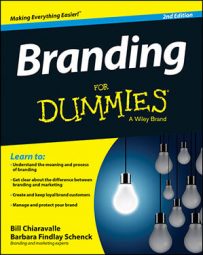The best name, logo, ads, and efforts can’t compensate for a weak brand. But what’s a brand? And how do you build a strong one? These ten truths summarize the key points you have to know.
Branding starts with positioning
Positioning is the process of finding an unfulfilled want or need in the consumer’s mind and addressing it with a distinctively different offering.
Remember these rules about positioning:
Your position must be open. Otherwise, you’ll need to dislodge an existing brand — and that’s a big and costly challenge to tackle.
Your position must be based on a unique point of difference that’s believable, meaningful, and attractive to consumers.
Your point of difference must be one that you can deliver with such consistency that every experience with your brand reminds customers of why they chose and remain loyal to your brand.
A brand is a promise well kept
You build your brand by reinforcing your promise every time people come in contact with you or with any facet of your organization — whether as customers, prospects, investors, employees, suppliers, friends, neighbors, or others; whether in person, online, through word-of-mouth, or through personal experiences; whether before, during, or after a purchase; and whether they’re interacting with you, your staff, your products, your marketing or social messages, or any other form of encounter.
Branding happens from the inside out
To arrive at a brand that accurately reflects the essence of your organization, begin the branding process by writing three essential statements:
Your vision statement, which defines the long-term aspirations of your organization and the ultimate good you aim to achieve.
Your mission statement, which defines what you do for others and the approach you’ll follow to achieve your vision.
Your brand statement, which defines what you do and the positive difference you promise to make in the lives of those you serve.
Consistency builds brands
After you’re clear about what your brand stands for, be prepared to reinforce it by delivering your product, promise, and brand experience with total consistency.
Create a brand that customers can recognize and count on by
Displaying a consistent look
Projecting a consistent brand character
Delivering a consistent level of quality in all communications, products, and services
Staying consistently true to what your brand is, stands for, and promises
People power brands
Passionate employees and passionate customers — in that order — power great brands. If you develop brand understanding, enthusiasm, and commitment within your organization, customer understanding, enthusiasm, and commitment will follow.
A great brand name, logo, promise, and communication program are essential ingredients for brand success, but nothing tops the need for an internal team of brand champions, beginning with the leader of your organization and including every single person who affects the consumer’s experience with your offering.
Brands live in consumers’ minds
When people see your logo or hear your name, they automatically conjure up impressions and memories that determine what they believe about you. Their notions may be the result of firsthand encounters, communications they’ve seen or heard, or web searches, social-media posts, or secondhand recaps of other customers’ experiences.
Regardless of whether the beliefs customers hold about you are many or few, or good or bad, they comprise the image of your brand and they influence how people think and buy.
Your brand image lives in your customers’ minds whether you intentionally put it there or not.
Brand names and logos are like keys that unlock brand images
The right name establishes your brand from the day it’s announced, and it grows with your business and your vision as you reach into new market areas, new geographic regions, and even new product areas.
A great brand name should
Reflect the brand character of your business.
Describe your offering and convey an association to the meaning of your brand.
Convey or be consistent with your brand promise.
Be easy and pleasant to say and unique and memorable so that, over time, it appreciates into an asset that you can harvest through premium pricing, licensing, or even a sale to a new owner.
Brand experiences trump brand messages
When consumers gravitate to one brand over the others, their decisions are rarely based on reactions to marketing messages alone. Instead, people rely on their own experiences or on what they’ve learned about the experiences of others. They choose and stay with brands that they believe will keep their promises based on what they’ve personally seen and sensed.
To create a brand experience capable of moving markets and instilling loyalty, be ready to convey and reinforce your brand promise through every encounter with your organization. If one portion of the experience falls short of consumer expectations — from one poorly handled phone call to one erroneous invoice — your brand image suffers.
Brands need to start and stay relevant
To win and keep a slot in the consumer’s mind, your brand needs to begin and remain credible, competitive, current, and relevant to customer wants, needs, and interests. That means you need to tune in to market conditions, consumer preferences, and cultural trends on a regular basis as your brand ages.
Markets change, and businesses change. When they do, brands that remain stuck in times past pay a high price in terms of credibility and competitiveness.
Either way, the revised brand strategy that you adopt should represent your brand vision for at least ten years, which is about the frequency that brands should undergo major change.
Brands are valuable assets
When companies with great brands are sold, the value of the brand often accounts for as much as half of the sale price. Plus, brand value translates into everyday economic benefits, including
Premium pricing and reduced price sensitivity
Lower costs of sales and promotions
Higher market share
Reduced threat of competition
Greater employee satisfaction
Higher recognition by consumers, industry leaders, media, investors, and analysts

